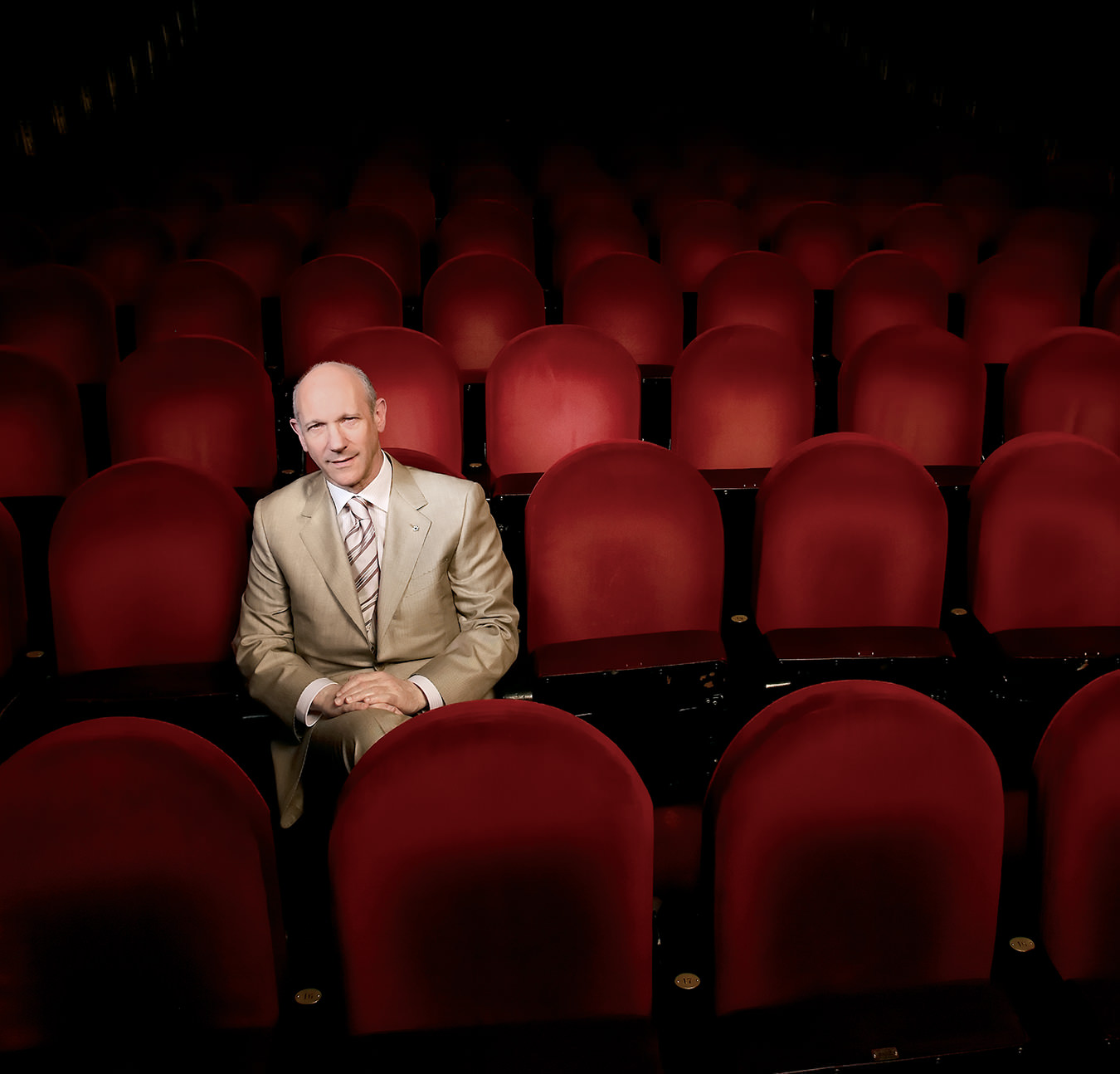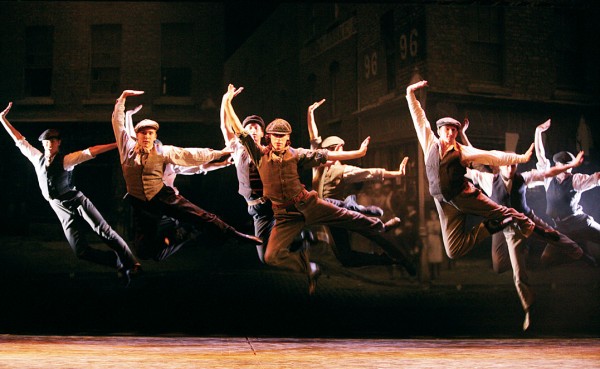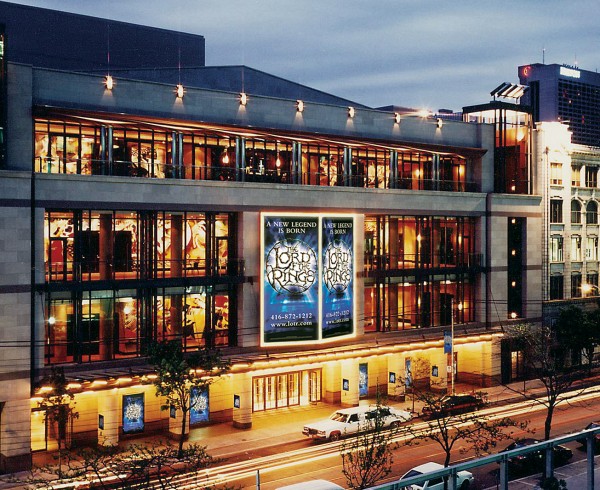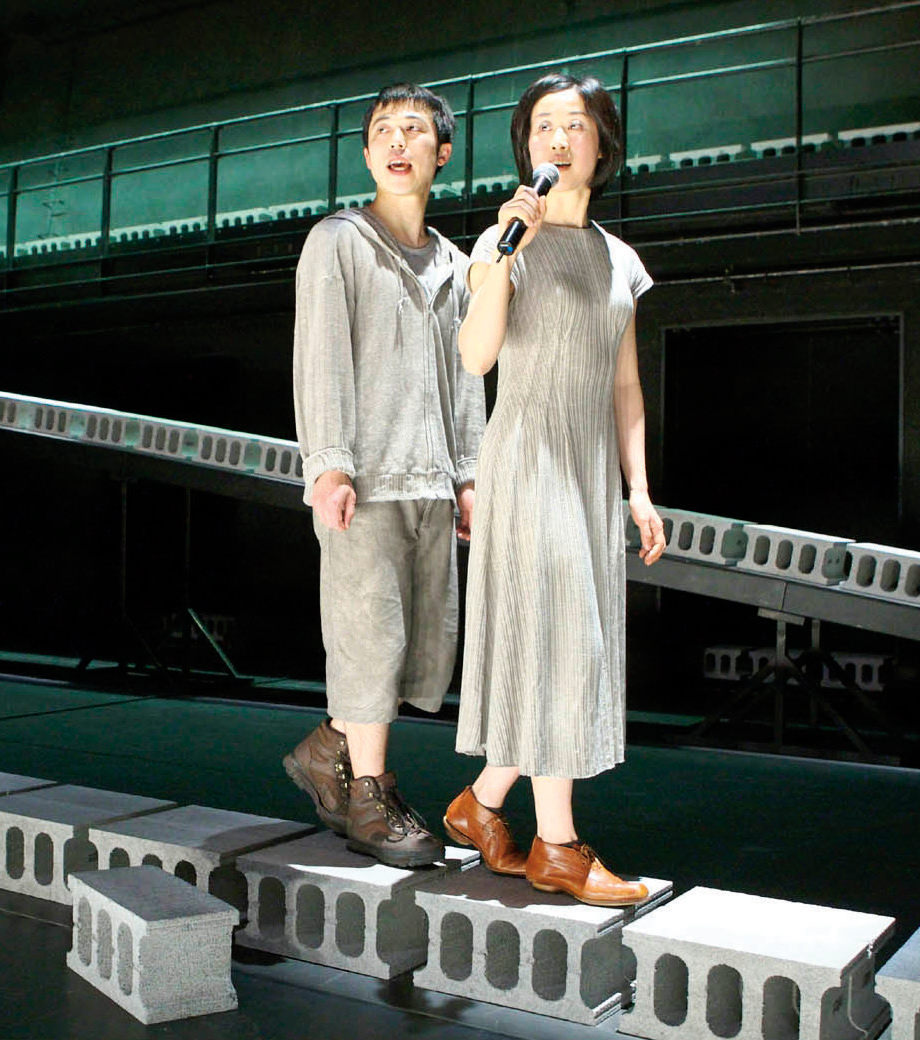-

David Mirvish.
-

The stage production of Dirty Dancing. Photo by David Scheinmann.
-

The Royal Alexandra Theatre. Photo by Brockhouse.
David Mirvish
Tales from the footlights.
“Honest Ed” Mirvish likes to claim that, before he bought Toronto’s Royal Alexandra Theatre in 1963, he had no experience in show business. Who is he kidding? The discount department store he opened in 1948 had been the scene of an illegal, 72-hour dance marathon (illegal because it violated store-hour bylaws), an in-store roller skating derby, a pink elephant sale with a real elephant painted pink (which Ed promptly scrubbed down after animal-rights groups explained that elephants keep cool through the pores of their skin), and a staged visit from the “Wolf Woman of the Yukon”, who ostensibly drove her dogsled team all the way down to Toronto to visit Honest Ed’s emporium.
“I didn’t know it wasn’t normal,” says David Mirvish of his childhood amid the publicity stunts and bargain bins of his father’s wacky world of retail theatre. Now a successful showman in his own right, the head of Mirvish Productions is getting ready to celebrate the 100th anniversary of the Royal Alexandra Theatre with the North American stage debut of Dirty Dancing, currently a sensation in Europe. The season is rounded out by Sweeney Todd, Stephen Sondheim’s grim tale of revenge and murder in Victorian London (a film version starring Johnny Depp is currently in the works), the courtroom drama Twelve Angry Men, The Life and Adventures of Nicholas Nickleby, Parts I and II, and The Ha’Penny Bridge, a musical set against the backdrop of the Irish Civil War, to be directed by Stratford’s Donna Feore.
The Royal Alex stood a very good chance of becoming a parking lot by the time it limped onto the market in 1963. It was dark—meaning no productions—40 weeks of the year, and woefully rundown. The much bigger O’Keefe Centre (now the Hummingbird Centre) had just opened, and all the touring shows were going there. Anyone who knew anything about the theatre business was loath to take a chance on the Grand Old Lady of King Street, whose party days, it was widely acknowledged, were over. It took a discount shopkeeper with a knack for showmanship and an eye for bargains to see the potential for a comeback. To some extent, Ed’s acquisition of the Royal Alex was another publicity stunt, a form of advertising for his core business. “Toronto was an extremely conservative city back in the 50s,” says David. “Newspapers would write a story saying, ‘Wolf girl arrives in Toronto at the corner of Bloor and Bathurst,’ but they wouldn’t be so commercial and crass as to put the name of the store where she made her appearance. Once my father bought the theatre, people carried around his shopping bag saying, ‘It’s fun to shop at Honest Ed’s,’ and they felt like they were patrons of the arts for doing it.”
It was also an investment. “I knew a bargain when I saw one,” Ed said in a 1989 speech to the Empire Club of Canada. “They spent $750,000 to build that theatre in 1907, and I was able to buy it for $215,000, including the land.” He promised to keep it going as a theatre for at least five years, a condition he himself imposed to make his offer more attractive. It cost him double the purchase price, however, to make it presentable enough to meet that condition. In addition to repairs and updates, including a modern lighting system, he restored the authentic details of the theatre’s original French Renaissance style. It reopened in September 1963 with the comedy Never Too Late, starring William Bendix and produced by Ed Mirvish. Five years later, it was making a profit, and Ed had been bitten by the theatre bug. Four decades later, it stands as one of the jewels on the North American touring circuit and a pillar of Toronto’s cultural arts scene.
“He didn’t buy it altruistically, to fund it,” says David, “because he felt that anything you had to subsidize was at risk, and someday, for some reason, you wouldn’t be able to subsidize it anymore. But he thought it could make its own way and he could make a living from it. He couldn’t have stayed at it without being successful. All the other offers were for parking lots, so he thought, ‘If I don’t succeed at the end of five years, then I’ll do what everyone else is doing.’”

Production of Ha’Penny Bridge. Photo by ©Kassan Productions Ltd.
In the beginning, Ed Mirvish mostly brought in shows from London’s West End or from Broadway, and then later became a producer. An early triumph was the 1972 musical Godspell, starring Gilda Radner, Eugene Levy, Andrea Martin, Martin Short and Victor Garber, who would reprise the role of Jesus in the film version. The musical conductor was Paul Shaffer, who went on to Saturday Night Live and the Late Show with David Letterman. The show was radical at the time, and good for publicity, although the Mirvishes feared it would be shut down because it was the first time frontal nudity had been shown on the legitimate stage in Toronto.
At the time his father was beginning to stir things up in the theatre world, David set out to distinguish himself in the art world. “While everyone else was studying English in high school, I would be in the back of the room reading John Rewald’s History of Impressionism,” he says. His mother, Anne, a sculptor, was also an influence. At the age of 19, he took the money he’d saved up, about $1,800, enough to cover the rent for a few months, and opened the David Mirvish Gallery. His first coup was enlisting the help of Leo Castelli, an important gallery owner in the flourishing pop-art world of 1960s New York. This was facilitated by Casey Messenger, his father’s advertising manager at the time, who, when David mentioned he wished he could meet Castelli, said, “No problem, David. Leo is my cousin.” She gave him a letter of introduction, and he went to New York. “When I got to the appointment,” says David, “I handed him the letter in a sealed envelope. He opened it, read it, and said, ‘What can I do for you, young man?’ Years later—we were in a gondola in Venice—I asked him what the letter said, and he replied, ‘It said you were a nice young man and I should try to help you.’ I asked him if he knew Casey, and he said, ‘I never heard of her in my life.’”
During the eight years he ran the gallery, David made a name for himself as a prominent Canadian art dealer. Today, it remains a successful art-book store, at the same location on Markham Street. “I stopped in part because I’d learned as much about myself as the artists,” says David. “And I’d reached a point where running the gallery was a very expensive way to use my time. I was dealing with living artists, so I was on the phone all the time. I thought I’d have greater success in a more normal business environment.”
Having auditioned his business acumen and affinity for the artistic personality, David was ready to take a leading role at Mirvish Productions in 1971. He recalls arriving at work one day, early in his new, “normal” job, to find a note on his desk requesting that he paint one of the dressing rooms at the Royal Alex black. It was during the mid-70s run of Home Sweet Homer, and the show’s star, Yul Brynner, apparently wanted his dressing room to match his sweaters. “The next day, I was over at the Windsor Arms, where Yul was staying, and the manager, George Minden, said, ‘David, do you know where my prints have gone? There was a Picasso and a Matisse in Mr. Brynner’s room, and they seem to have disappeared.’ Sure enough, they were in his dressing room. Yul wanted some bright colours against the dark background.” With a twinkle in his eye and an intensity that makes him look even more like actor Ben Kingsley than people say he does, David reflects, “Theatre is normal, but it’s not normal.”
He and his father staged a string of mostly successful productions over the next few years, including Spoils of War, Stones in His Pockets and The Mikado, all of which went on to Broadway. In 1993, they built the 2,000-seat Princess of Wales Theatre next door, as there was no theatre in Toronto that could accommodate large sets, such as those used in the helicopter scene in Miss Saigon. Earlier, in 1982, they bought the Old Vic in London for $1-million, outbidding Andrew Lloyd Webber for the 1818 landmark. The Old Vic turned into a whirlwind, 16-year adventure for the Mirvishes, but it was a roller coaster ride. Theatre is a world of flops and triumphs, in which critical and financial success don’t always coincide. There were years when Old Vic productions won more awards than any other theatre in England, yet wound up entirely profit-free. In 1999, Mirvish Productions sold the Old Vic for $10-million to a non-profit organization. Kevin Spacey is the current artistic director.

The Princess of Wales Theatre. Photo by Evan Dion.
“The first lesson I learned about owning a theatre was the fact that as long as you keep the theatre locked up, you know exactly how much it costs you every week,” Ed Mirvish said in 1989. “Once you open the door and put a production on the stage, it could be risky to the point of putting you in bankruptcy. For 20 years I complained what an aggravation it was, and then I bought the Old Vic in London. People close to me just shook their heads.”
Staging productions in Toronto is no less volatile. The Mirvishes’ triumphs are well documented—Miss Saigon, Beauty and the Beast, Les Misérables, Cats, Mamma Mia!, The Lion King. But so are the failures, including Legends!, starring Joan Collins and Linda Evans, and most notably the $33-million production of The Lord of the Rings. Because it relied on a cast of more than 50 actors and a set that included a 40-ton, computer-controlled stage floor with 17 elevators, the show had to be more than a success in order to break even. It had to be a sensation. It was neither. After bad reviews and disappointing sales, The Lord of the Rings shut down in September 2006, just five and a half months after opening. Some people close to the production blamed a fall-off in Toronto tourism. Others said the critics had been overly harsh. David is less circumspect: “It didn’t work because, in the theatre, you can’t be 85 per cent good, you have to be 110 per cent good. You have to catch people’s imagination in a way that makes them receptive immediately. This is a show that we were told would be three and a half hours in its first performance. In its first performance, it was five hours. Word of mouth within three days was out—you weren’t going to The Lord of the Rings, you were going to the Ring cycle, you were going to Wagner. Eventually we got it down to three and a half hours, but it was too late.”
In addition to brutal reviews, there was flak about the investment of tax dollars from the City of Toronto and the Province of Ontario, which makes David bristle, more so than the bad reviews. Tourism Toronto invested into the production $3-million of its $24-million dollar advertising budget for that year, which is collected from a voluntary 3 per cent tax on Toronto hotels. “I can’t see anything else that could possibly have given them anywhere near the visibility for Toronto that they got worldwide for the city for 18 months. You had the front page of London newspapers, and travel forums all over the world. In the end, 420,000 people went to the show, at least 180,000 of which came and stayed overnight in Toronto. That’s about 90,000 hotel room nights. People ate dinners and came downtown. The city knew their investment was worth it, whether the show succeeded or not.”
As for the Province, David says, “we spent $33-million to produce the show. Part of that was spent on wages and items purchased here, on which we paid provincial sales tax. Then we ran the production for six months with a budget of somewhere around $800,000 or $900,000 a week, paid in expenses and wages. If you calculate the provincial sales and income tax alone on those expenditures, the provincial government made a $1.2-million profit on its investment of $4.2-million. Those of us who were normal investors—the ones who put up the other $22-million—we’re the people who have lost money.” He is quick to add: “But we have an ongoing investment in London [where the show opened this May], so we don’t know yet how it will finish.”
After 35 years in the business, the 63-year-old producer is not easily rattled by the ups and downs of theatre. “It’s the way it works,” David says. “Either you can’t make a living or you can make a killing. Once in a while something really big comes along. When it really works, suddenly you can be all over the world, and that’s the great temptation. Theatre owners are concerned with filling their buildings day-to-day and making a living at that, but people who really want to stand out and be seen produce shows, because when your show hits, it isn’t just one production. Mamma Mia! was a great success in London. We were the gateway into North America. There were eventually five North American companies. And they all more than doubled their money. Some of them tripled and quadrupled their money. The two most successful shows ever, Cats and Phantom of the Opera, sold about $3-billion worldwide each, and Mamma Mia! is expected to surpass that.”
At 92, “Honest Ed” Mirvish is in good health and remains reasonably active (although not in the business). He will no doubt be remembered as, among other things, a great master of the publicity stunt. One of the many honours bestowed on him over the years was the status of Freeman of the City of London. This distinction carries certain archaic privileges, one of which is that if he were sentenced to be hanged for some reason, he had the option of a silk, rather than hemp, rope. It also carries the privilege of taking your sheep across London Bridge without paying a toll. Ever the showman, Ed promptly hired a flock of sheep and conveyed them across London Bridge.
An interviewer once asked Ed what he would like on his tombstone, and how he would like to be remembered. He has always answered this question with the same reply: “I’m not that interested in tombstones and cemeteries, but would like a huge throne to be erected in the centre of Honest Ed’s. I would like my body cremated and the ashes put in an hourglass. Someone sitting on the throne would keep turning the hourglass up and down, up and down, and the employees would point to it and say, ‘There’s Ed. He’s still running!’”




